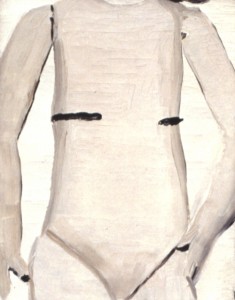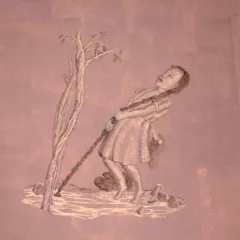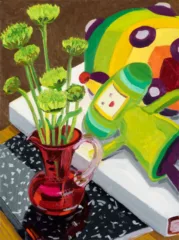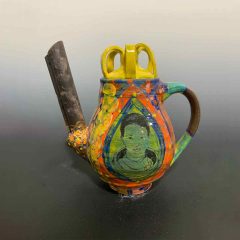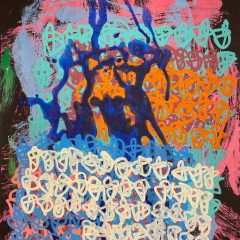Post by Lauren Whearty
I have been to the Luc Tuymans exhibit at the Wexner Center at least 5 times in the past few months. There are four or five galleries set up to exhibit different stages of the work, which progress in a mostly chronological order. Each room, or section is curated to summarize or reconstruct past exhibitions of Tuymans work, and to place his retrospective in context with the time and place where it was created. Reconstructing these previous shows is important in that Luc makes paintings with the consideration of installation, as each painting in a room reveals elements about the subject which he is unearthing. This exhibition covers work from when Tuymans was in his twenties, to work that was made only a couple years ago, in observation of the post 9-11 atmosphere of America.
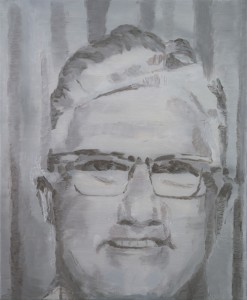
One of the earliest paintings in the show is “Gaskamer” or “Gas Chamber”. The room appears dead and desolate, vacant. You get the impression that something is not right, but you can’t quite place what it is. The next step is to read the title, as you search for clues into the painting. It is here that Luc reveals everything, the horror, the violence, and the ominous silence of death. These elements are not quite visible, yet they are there, somehow the viewer is able to sense the history of this place without even knowing the title. The most suspenseful part is wondering what happened here, or what might happen in such a place. The timing in that suspense allows the painting to resonate, the image fades and the content remains to haunt you.
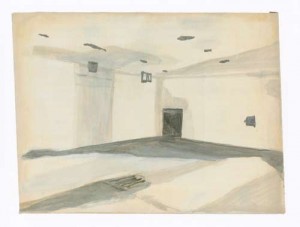
Because of the way that Luc suppresses information, the work opens and processes slowly to the eye and mind. Many seemed to have an “unimpressed” or “underwhelmed” first impression of the show. Upon multiple visits, information is revealed through the audience’s participation in research and curiosity. Each unassuming painting requires background knowledge and hints from titles and descriptions to be clued in to the narrative. These paintings and their histories open up to the viewers, once they catch on to the amount of content that is left unsaid in Tuymans’ paintings. Because this exhibition requires constant research and questioning of the material at hand, it really becomes about looking and studying. As a Belgian painter growing up in post World War II era, he has had a very skeptical experience of government, people, and political actions. Topics covered within the exhibition include, the Holocaust, Belgian political extremist parties, Belgians in the Congo, Terrorism, The Bush Presidency, Racism, the Disney Corporation, etc.
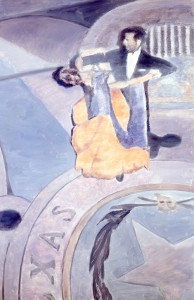
Ballroom Dancing is a great example of his perception of the post 9-11 attitude of Americans. During a tour with assistant curator, Amanda Potter, I learned that Luc used ballroom dancing as a metaphor for safety and regression in society. Because ballroom dancing is a very traditional and safe form of dance, where the man leads, and the woman follows, Luc imagined that the predictability of this form of dance made Americans feel comfortable. He noticed that during post 9-11 times, reality shows featuring ballroom dancing contests became very popular, giving the American people a form of entertainment that felt relaxed and safe, with little to question. The image from this painting came from an internet search of a Texas governor’s ball, so you can see on the floor, the Texas state seal, as well as the United States seal. He found this to be perfect symbolism of the journey of President Bush from Texas to the White House. Therefore this seemingly simple image, develops and becomes important based on the content that it hints at.
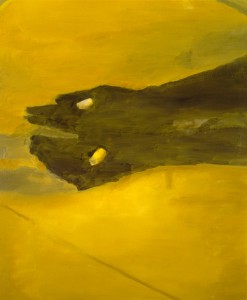
Chalk is another particularly haunting painting. The image is unclear, it appears as though there is a hand, or shadow of a hand holding chalk, but those white marks may also be holes in the shadow or hand. If the white marks are chalk, it appears to have been broken, as if someone has just dropped or snapped the chalk. This painting is located in a room dedicated to recreating Luc Tuymans’ exhibition at a previous Venice Biennale, where he chose to address the Belgian presence in the Congo. This was received well by everyone who was not Belgian. In this room he tells the stories of assassination, racism, and political power gone terribly wrong. So immediately you are aware that there is more to this painting than what is visible. Amanda Potter also filled my group in on the back story to this painting – after an assassination of the first black Congo president, the body was disposed of in an inhumane manner, to prevent any relics of martyrdom from being saved. One man claims to have pulled out some of this man’s teeth before helping to dispose of the body. This could be a myth, it could be true, no one will ever know, but the destruction, mystery and violence is all quietly located in this painting, begging the viewer to do the research, to dig deeper.
Luc Tuymans’ paintings are most importantly about looking, and about awareness, and training oneself to think critically. The heated topics covered wouldn’t have so much weight and resonance about them if they did not teach the viewer. Through his use of photographs, film, and other media sources, he is able to use those images to present material that could never covered in one painting, or a thousand paintings. As mentioned in his lecture, propaganda images and icons do not tell the viewer exactly what to believe, or what to conclude, yet they conjure up the material surrounding the issues, to influence people. Therefore, it is always important for Tuymans to hold back as a painter, and a storyteller, as it is our job, as viewers and participants to investigate events that are occurring in our own time, to unearth truths that are not exposed by the media, and to learn from the horrors that have occurred in modern times.
Tuymans requires a lot from his audience, and because of that, spending time with his work is a rewarding experience. As Tuymans also mentioned in his lecture, “the painting will never speak for itself, the painting is fucking mute”. The more you look, the more you see, and the more work you will have to do to get to the issues and to the painting itself. During the act of investigating the paintings, we are rewarded with those moments where we can momentarily suppress the dark content, and see the work for what they are, paintings. They are just as much, if not more, about the fleeting gestures of light, touch and timing as they are about content. You see how much is held back by the artist during his working process, yet we also see how much is also revealed through the act of painting.
Luc Tuymans: Wexner Center for the Arts in Columbus, September 17, 2009 to January 3, 2010. SFMOMA (February 6 to May 2, 2010), the Dallas Museum of Art (June 6 to September 5, 2010), the Museum of Contemporary Art in Chicago (October 2, 2010 to January 9, 2011), and the Bozar Centre for Fine Arts in Brussels (February 11 to May 8, 2011)
—Lauren Whearty is an MFA student in painting at Ohio State University with a BFA from Tyler School of Art.


